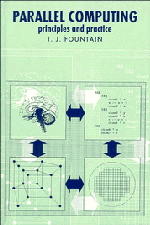1 - Introduction
Published online by Cambridge University Press: 29 September 2009
Summary
Before attempting to understand the complexities of the subject of parallel computing, the intending user or student ought, perhaps, to ask why such an exotic approach is necessary. After all, ordinary, serial, computers are in successful and widespread use in every area of society in industrially developed nations, and obtaining a sufficient understanding of their use and operation is no simple task. It might even be argued that, since the only reason for using two computers in place of one is because the single device is insufficiently powerful, a better approach is to increase the power (presumably by technological improvements) of the single machine.
As is usually the case, such a simplistic approach to the problem conceals a number of significant points. There are many application areas where the available power of ‘ordinary’ computers is insufficient to obtain the desired results. In the area of computer vision, for example, this insufficiency is related to the amount of time available for computation, results being required at a rate suitable for, perhaps, autonomous vehicle guidance. In the case of weather forecasting, existing models, running on single computers, are certainly able to produce results. Unfortunately, these are somewhat lacking in accuracy, and improvements here depend on significant extensions to the scope of the computer modelling involved.
- Type
- Chapter
- Information
- Parallel ComputingPrinciples and Practice, pp. 1 - 29Publisher: Cambridge University PressPrint publication year: 1994



